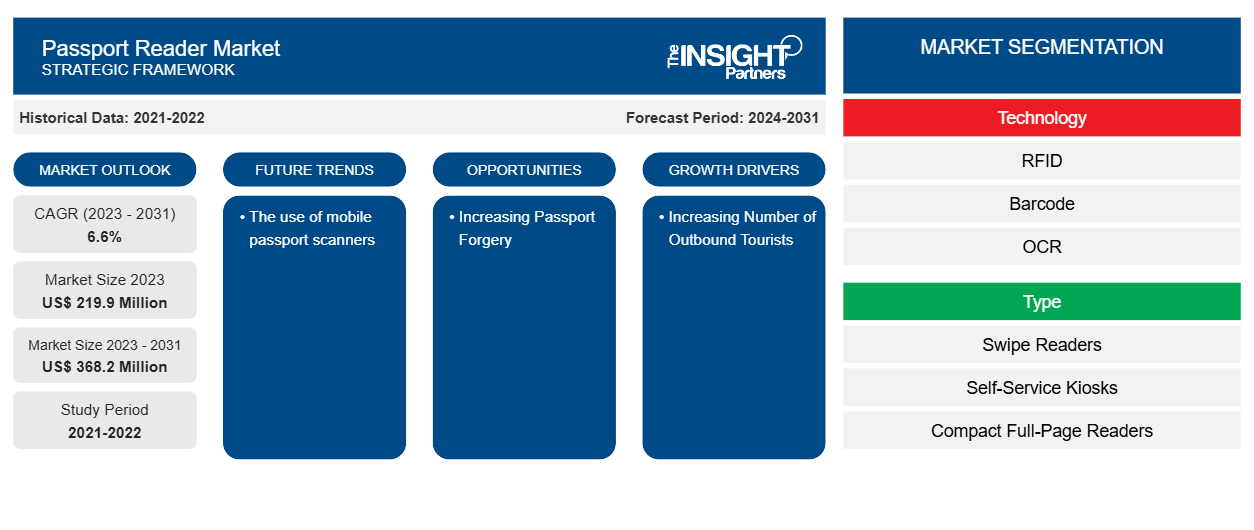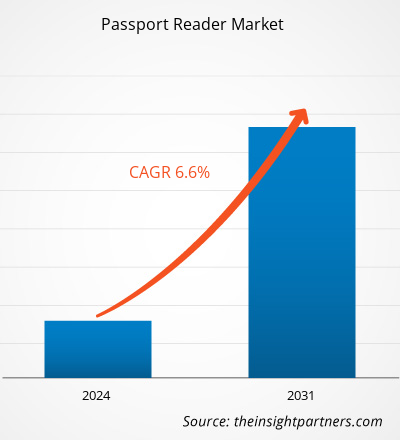The passport reader market size is projected to reach US$ 368.2 million by 2031 from US$ 219.9 million in 2023. The market is expected to register a CAGR of 6.6% during 2023–2031. The use of mobile passport scanners is likely to remain a key trend in the market.
Passport Reader Market Analysis
Passport readers help detect forgeries and verify the identity in various law enforcement applications, mostly by the police. Governmental entities aside, commercial applications use passport readers to register guest data quickly and automatically. Passport scanners with appropriate verification software can detect production failures and discrepancies. They play a key role in the quality assurance process of identity document production.
Passport Reader Market Overview
A passport reader or passport scanner is actually a camera – a purpose-built imaging device that takes photos of the presented identity documents. The difference between a regular camera and a passport scanner is that the latter uses special illumination when capturing the document. In addition to visible white, it includes infrared and ultraviolet light sources as well. The images taken under these illuminations are used for specific image processing tasks, mainly for data reading and document verification. During the passport reading process, the Optical Character Recognition (OCR) software analyzes the scanned images. First, it identifies the document type and then digitalizes the characters. It outputs segmented personal and document data, such as name, date of birth, nationality, document number, expiry date, and more.
Customize This Report To Suit Your Requirement
You will get customization on any report - free of charge - including parts of this report, or country-level analysis, Excel Data pack, as well as avail great offers and discounts for start-ups & universities
Passport Reader Market: Strategic Insights

-
Get Top Key Market Trends of this report.This FREE sample will include data analysis, ranging from market trends to estimates and forecasts.
Passport Reader Market Drivers and Opportunities
Increasing Number of Outbound Tourists to Favor Market
According to the Federation of Indian Chambers of Commerce and Industry (FICCI), international tourist arrivals have reached 80% of pre-pandemic levels in the first quarter of 2023, boosted by strong results in Europe and the Middle East, compared to a 66% recovery level for the year 2022. An estimated 235 million tourists travelled internationally in the first three months, more than double those in the same period of 2022. The Middle East saw the most impressive performance (+15%) and is the first world region to recover pre-pandemic numbers in a full quarter. Europe achieved 90% of pre-pandemic levels in Q1 2023, supported by strong intra-regional demand. Further, the Indian National Departures have registered a growth of 59.2% with respect to 2022. UAE, Saudi Arabia, USA, Singapore, and Thailand are the top destinations for Indian travellers. India's outbound tourism market is estimated to reach US$ 15163.4 Million in 2022 and is projected to rise by 11.4% CAGR between 2022 and 2032. Thus, with the growing tourism, the need for efficient border control systems increases, which drives the growth of the market.
Increasing Passport Forgery
Countries with weaker security measures used in passports and other documents usually have higher rates of forged IDs. The price of issuing legal identity documents reflects this. According to William Russel, an international insurer, an Australian passport is the most expensive travel document in the world now—US $230 per issue. Further, countries with the highest level of welfare, such as the US, Canada, or Germany, come to mind first when speaking about the most often faked IDs and passports. Usually, they are destinations for illegal immigrants. For example, in April 2024, the Fake Passport Investigation Wing of Greater Chennai City Police arrested six Bangladeshi nationals who produced Indian passports at Chennai International airports in the last two days. All of them had obtained Indian passports fraudulently based on Aadhar cards obtained here over the years. They used the Indian passports and had flown to Dubai, Kuwait or Malaysia for work as well. Such instances drive the growth of the market.
Passport Reader Market Report Segmentation Analysis
Key segments that contributed to the derivation of the passport reader market analysis are technology, type, application and sector.
- Based on the technology, the passport reader market is segmented as RFID, barcode, and OCR.
- Based on the type, the passport reader market is segmented into swipe readers, self-service kiosks, compact full-page readers, and portable readers.
- Based on the application, the passport reader market is segmented into airport security, border control, and other applications.
- In terms of sector, the market is segmented into public and private.
Passport Reader Market Share Analysis by Geography
The geographic scope of the passport reader market report is mainly divided into five regions: North America, Asia Pacific, Europe, Middle East & Africa, and South & Central America. Passport readers help detect forgeries and verify the identity in various law enforcement applications, mostly by the police. Governmental entities aside, commercial applications use passport readers to register guest data quickly and automatically, due to which the adoption of passport readers is growing globally.
Passport Reader Market Regional Insights
The regional trends and factors influencing the Passport Reader Market throughout the forecast period have been thoroughly explained by the analysts at The Insight Partners. This section also discusses Passport Reader Market segments and geography across North America, Europe, Asia Pacific, Middle East and Africa, and South and Central America.
Passport Reader Market Report Scope
| Report Attribute | Details |
|---|---|
| Market size in 2023 | US$ 219.9 Million |
| Market Size by 2031 | US$ 368.2 Million |
| Global CAGR (2023 - 2031) | 6.6% |
| Historical Data | 2021-2022 |
| Forecast period | 2024-2031 |
| Segments Covered |
By Technology
|
| Regions and Countries Covered |
North America
|
| Market leaders and key company profiles |
|
Passport Reader Market Players Density: Understanding Its Impact on Business Dynamics
The Passport Reader Market is growing rapidly, driven by increasing end-user demand due to factors such as evolving consumer preferences, technological advancements, and greater awareness of the product's benefits. As demand rises, businesses are expanding their offerings, innovating to meet consumer needs, and capitalizing on emerging trends, which further fuels market growth.

- Get the Passport Reader Market top key players overview
Passport Reader Market News and Recent Developments
The passport reader market is evaluated by gathering qualitative and quantitative data post primary and secondary research, which includes important corporate publications, association data, and databases. A few of the developments in the passport reader market are listed below:
- Beijing Wintone Science & Technology Co. Ltd. announced the launch of Ota's new passport reader device integrated with face recognition technology for the e-gate application. It can recognize any document in compliance with ICAO 9303.
(Source: Beijing Wintone Science & Technology Co. Ltd., October 2022)
- DESKO GmbH announced the launch of Ota's new PENTA Scanner 4X Cube. It is better, faster, and more efficient than the company's other scanners, which can scan all the documents needed.
(Source: DESKO GmbH, October 2022)
Passport Reader Market Report Coverage and Deliverables
The “Passport Reader Market Size and Forecast (2021–2031)” report provides a detailed analysis of the market covering below areas:
- Passport reader market size and forecast at global, regional, and country levels for all the key market segments covered under the scope
- Passport reader market trends, as well as market dynamics such as drivers, restraints, and key opportunities
- Detailed PEST/Porter’s Five Forces and SWOT analysis
- Passport reader market analysis covering key market trends, global and regional framework, major players, regulations, and recent market developments
- Industry landscape and competition analysis covering market concentration, heat map analysis, prominent players, and recent developments for the passport reader market
- Detailed company profiles
Frequently Asked Questions
Which region dominated the passport reader market in 2023?
What are the driving factors impacting the passport reader market?
What are the future trends of the passport reader market?
Which are the leading players operating in the passport reader market?
What would be the estimated value of the passport reader market by 2031?
What is the expected CAGR of the passport reader market?
- Historical Analysis (2 Years), Base Year, Forecast (7 Years) with CAGR
- PEST and SWOT Analysis
- Market Size Value / Volume - Global, Regional, Country
- Industry and Competitive Landscape
- Excel Dataset
Recent Reports
Testimonials
Reason to Buy
- Informed Decision-Making
- Understanding Market Dynamics
- Competitive Analysis
- Identifying Emerging Markets
- Customer Insights
- Market Forecasts
- Risk Mitigation
- Boosting Operational Efficiency
- Strategic Planning
- Investment Justification
- Tracking Industry Innovations
- Aligning with Regulatory Trends





















 Get Free Sample For
Get Free Sample For